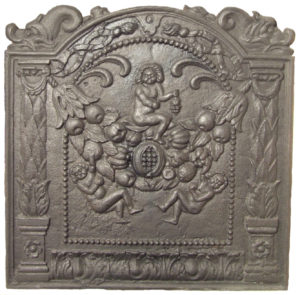
The emergence, in the second half of the 17th century, of a distinct style of fireback produced for the Dutch market by ironworks in the German principality of Nassau-Siegen gradually influenced the design of firebacks in Britain. Particularly in London, after the devastation of the Great Fire in 1666 and the consequent rebuilding of a substantial area of the city, the progression from the use of wood to that of mineral coal for domestic heating led to narrower fireplaces being installed in new houses. The wide firebacks familiar in inglenook downhearths were no longer suitable and the ‘Dutch’ style of backs, which were narrower and taller, began to be imported and adopted. English pattern-makers started to produce imitations of the German types. This style is characterised by a central illustrative compartment within arched rectangular edging surrounded by a decorative border and sometimes surmounted by a pair of sea serpents.

The earliest manifestation of this change can be found in what I have termed the Carolean ‘Dutch’ series, a small number of which have columns forming the border at the sides of the central compartment, echoing Mannerist paintings often of biblical scenes. An example of this style of English fireback is one depicting the Stocks Market statue of Charles II erected in 1672. The fireback’s date of 1674 usefully narrows the period for the production of firebacks in this style.


Two firebacks from this series, also with columns on each side of the central panel, each depict a swag of fruit with putti disporting themselves upon it. While the designs differ in minor details the inspiration will have been the same and they are likely to have been the work of the same pattern-maker, who indeed may also have been responsible for the Stocks Market firebacks.

One artist in particular is known for his paintings of such scenes. Jan Pauwel Gillemans the Younger (1651-1704) was born in Antwerp. His father was a still-life painter, now best known for scenes of table tops covered with arrangements of fruit and vegetables, and sometimes of vanitas subjects incorporating memento mori. To begin with, the younger Gillemans followed his father, but he gradually moved away from those subjects to the production of ‘garland paintings’, which had been pioneered by Jan Brueghel the Elder. Gillemans developed the garlands, which Brueghel had used to enclose other scenes and, collaborating with other artists, placed them in landscapes populated by putti and small animals, notably guinea pigs, then recently introduced from South America.

On one painting by Gillemans the inscription ‘Londini’ and the date, either 1673 or 1678, can be made out, which seems to indicate that the painting was executed in London in one of those years, which is the same period that saw the production of one or both of the Stocks Market firebacks. Gillemans had become a Master of the painters’ Guild of St Luke in Antwerp in 1673-4 but had moved to Middelburg by 1675. It is thus more likely that he was in London in 1678, where he may have remained until 1680.
Gillemans’ London painting indicates that he was already established in the genre of garland subjects at that time, so he could have collaborated with, or inspired, a wood carver in the production of patterns for the two firebacks. Given the close correspondence between his paintings and the images on the firebacks it is difficult to contemplate that they could have been produced without either his participation or influence.